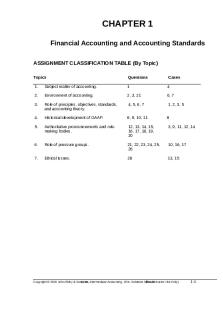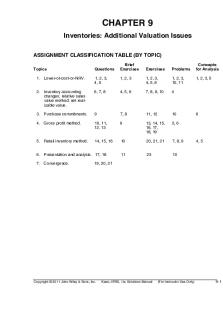Payroll Accounting 2015 25th Edition Bieg, Toland Solution Manual PDF

| Title | Payroll Accounting 2015 25th Edition Bieg, Toland Solution Manual |
|---|---|
| Author | Kelly Duncan |
| Course | Payroll accounting |
| Institution | Gadsden State Community College |
| Pages | 3 |
| File Size | 144.3 KB |
| File Type | |
| Total Downloads | 32 |
| Total Views | 128 |
Summary
Payroll accounting testbank...
Description
2015
TEST 2
e d i t i o n
PAYROLL ACCOUNTING Bieg/Toland
Student Chapter 2
INSTRUCTOR’S COPY
Date SCORING RECORD
Section Total Points A
40
B
60
Total
100
Deductions
Score
Section A—DIRECTIONS: Each of the following statements is either true or false. Unless directed otherwise by your instructor, indicate your choice in the Answers column by writing “T” for a true answer or “F” for a false answer. (2 points for each correct answer) For Answers Scoring
1. An enterprise is covered under the FLSA if there are at least two employees engaged in interstate commerce and if the enterprise has a gross annual sales volume of at least $100,000.........F
1.
2. Under the FLSA, “mom and pop stores” are excluded from enterprise coverage................................T
2.
3. If a small amount of tips is turned over to the employer, the tip credit can still be applied against the minimum wage....................................................................................................................F
3.
4. A discretionary bonus is not included in the calculation of the regular rate of pay...............................T
4.
5. Employees who regularly work less than 20 hours a week are not covered by the minimum wage requirements.................................................................................................................................F 6. A full-time student may be employed by a retail shop at 85 percent of the minimum wage................T
5. 6.
7. An employer may only credit up to half of a tipped employee’s minimum wage as coming from the tips actually received.................................................................................................F
7.
8. There are some states that have a higher minimum wage rate than the federal minimum....................T
8.
9. The FLSA provides for the payment of “double time” for any hours worked on holidays..................F
9.
10. Wage differentials between sexes would be allowed if the different wage rates were based on a seniority system...................................................................................................................T
10.
11. Blue-collar workers do not have to be paid for overtime if they have earned more than $90,000 for the year...............................................................................................................................F
11.
12. The FLSA requires employees to be paid for a rest period of 30 minutes or less................................. F 12. 13. Employers are not required to pay an employee for hours not worked because of illness................... T 13. 14. Time spent in training sessions is never counted as working time........................................................ F
14.
15. The FLSA specifies that the employer must record an employee’s starting and stopping time to the nearest tenth of an hour....................................................................................................... F
15.
16. A worker who is regularly paid on a biweekly basis should receive 24 paychecks each year.............. F
16.
17. In order to qualify for the “white-collar” exemption as outside salespeople, the employees must be paid a minimum salary of at least $455/week..........................................................................F 18. Commissions are considered to be payments for hours worked and must be included in determining the regular hourly rate.......................................................................................................T
18.
19. In calculating the overtime premium pay, the overtime hours are multiplied by one-half the regular hourly rate.................................................................................................................................T
19.
20. A nondiscretionary bonus is one that is either known in advance or is set up as an inducement to achieve certain goals. .......................................................................................................................T
20.
17.
ATS–1 © 2015 Cengage Learning. All Rights Reserved. May not be scanned, copied or duplicated, or posted to a publicly accessible website, in whole or in part.
ATS–2
Chapter 2/Achievement Test Solutions
Section B—DIRECTIONS: Solve the following problems and record the answers in the Answers column. Carry each hourly rate and each overtime rate to 3 decimal places and then round off to 2 decimal places. (6 points for each correct answer)
[2–2]
Full file at http://testbankshop.eu/Payroll-Accounting-2015--25th-Edition-Bieg,-Toland-Solution-Manual Answers
1. Diane Duke works a standard 40-hour workweek. She is paid time and one-half for all hours over 40 in each workweek. Her regular hourly wage rate is $10.90. One week, Duke worked 49 hours. Her total gross earnings for the week are [(40 × $10.90) + (9 × $10.90 × 1.5)]................................................................................................................$ 2. Charles Rollins earns $2,400 each month and works 35 hours each week. (a) His hourly rate is [($2,400 × 12) ÷ 52 ÷ 35]....................................................................$
For Scoring
583.15
1.
15.82
2a.
(3 pts.)
(b) His overtime rate is ($15.82 × 1.5)..................................................................................$
23.73
2b.
(3 pts.)
3. Ken Gorman is paid $405.00 for a 37½-hour workweek. Overtime is paid at time and one-half for hours beyond 40 in each workweek. One week, Gorman works 48 hours. If he is paid his regular hourly rate for the first 40 hours, Gorman’s gross pay is $405 ÷ 37½ = $10.80/hour; [$405 + (2.5 × $10.80) + (8 × $16.20)]....................................$ 4. Susan Tate receives an hourly wage of $11.25 for a 40-hour week of 5 days, 8 hours daily. For Saturday work, she is paid 1½ times the regular rate. For Sunday work, she is paid 2 times the regular rate. One week, she worked 50 hours—4 hours of which were on Saturday and 6 hours on Sunday. Her total earnings for the week are [(40 × $11.25) + (4 × $16.88) + (6 × $22.50)]..............................................................................................$ 5. Ronald Dowd receives an annual base salary of $47,500 as a salesman in the Southern region, which has an annual sales quota of $450,000. For all sales over this quota, Dowd receives a commission of 4½%. For the current year, sales in the Southern region total $698,000. The amount of salary and commissions due to Dowd is [$47,500 + ($248,000 × 0.045)]............................................................................................$ 6. Charles Geiger is a nonexempt salaried employee who works fluctuating workweeks. He is paid $760 per workweek. This week, he worked 50 hours. Determine Geiger’s total gross pay if his employer uses the special half-rate (based on total hours worked) for overtime pay ($760 ÷ 50 = $15.20 × 0.5 = $7.60 × 10 = $76.00 + $760) ...........................$ 7. Ron Morris earns $11.80 per hour and worked 44 hours this week. In addition, he earned a production bonus of $35.20 for the week. His gross pay for the week is (44 × $11.80 = $519.20 + $35.20 = $554.40 ÷ 44 = $12.60 × 0.5 = $6.30 × 4 = $25.20 + $554.40)........$
561.60
3.
652.52
4.
58,660
5.
836.00
6.
579.60
7.
8. Bob Knox is paid on a piece-rate basis. He is paid 30 cents for each unit he produces. For overtime work, he receives in addition to his piece-rate earnings a sum equal to one-half the regular hourly pay multiplied by the hours worked in excess of 40 in a week. During a particular week, Knox worked 45 hours and produced 1,890 units. His total earnings for the week are (1,890 × $0.30 = $567.00 ÷ 45 = $12.60 × 0.5 = $6.30 × 5 = $31.50 + $567.00).............................................................................................................................$ 9. Carson Morris worked two separate jobs for Horwath Company during the week. Job A consisted of 36 hours at $16.00 per hour; Job B entailed 14 hours at $17.50 per hour. Determine his gross pay for that week if the employer uses the average rate basis for the overtime pay [(36 × $16.00) + (14 × $17.50) = $821 ÷ 50 = $16.42 × 0.5 = $8.21 × 10 = $82.10 + $821.00]..............................................................................................................$
598.50
8.
903.10
9.
10. Cecil Green is a waiter who regularly receives $90 each week in tips and works 40 hours each week. Green’s employer claims the maximum weekly tip credit that is allowed in this case. The gross weekly pay, excluding tips, that the restaurant should pay Green without violating the FLSA is (40 × $7.25 = $290.00 – $90.00)..........................................$
200.00
10.
AT–3...
Similar Free PDFs

solution manual management accounting
- 895 Pages

Solution Manual Cost Accounting
- 46 Pages

Solution Manual Managerial Accounting
- 880 Pages

Solution Manual Managerial Accounting
- 880 Pages

5th edition solution manual
- 48 Pages

Cost Accounting Solution Manual Ch20
- 24 Pages
Popular Institutions
- Tinajero National High School - Annex
- Politeknik Caltex Riau
- Yokohama City University
- SGT University
- University of Al-Qadisiyah
- Divine Word College of Vigan
- Techniek College Rotterdam
- Universidade de Santiago
- Universiti Teknologi MARA Cawangan Johor Kampus Pasir Gudang
- Poltekkes Kemenkes Yogyakarta
- Baguio City National High School
- Colegio san marcos
- preparatoria uno
- Centro de Bachillerato Tecnológico Industrial y de Servicios No. 107
- Dalian Maritime University
- Quang Trung Secondary School
- Colegio Tecnológico en Informática
- Corporación Regional de Educación Superior
- Grupo CEDVA
- Dar Al Uloom University
- Centro de Estudios Preuniversitarios de la Universidad Nacional de Ingeniería
- 上智大学
- Aakash International School, Nuna Majara
- San Felipe Neri Catholic School
- Kang Chiao International School - New Taipei City
- Misamis Occidental National High School
- Institución Educativa Escuela Normal Juan Ladrilleros
- Kolehiyo ng Pantukan
- Batanes State College
- Instituto Continental
- Sekolah Menengah Kejuruan Kesehatan Kaltara (Tarakan)
- Colegio de La Inmaculada Concepcion - Cebu









